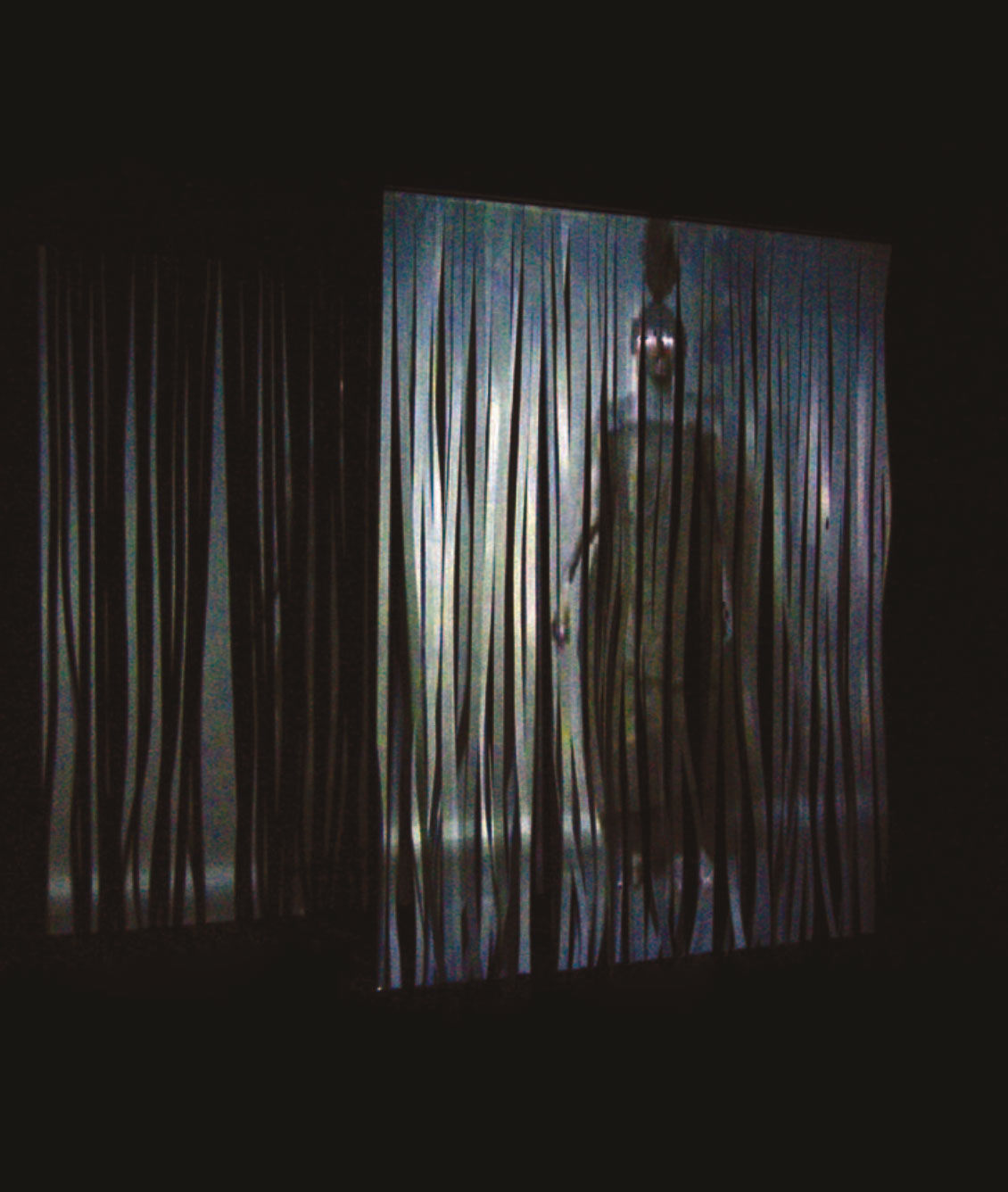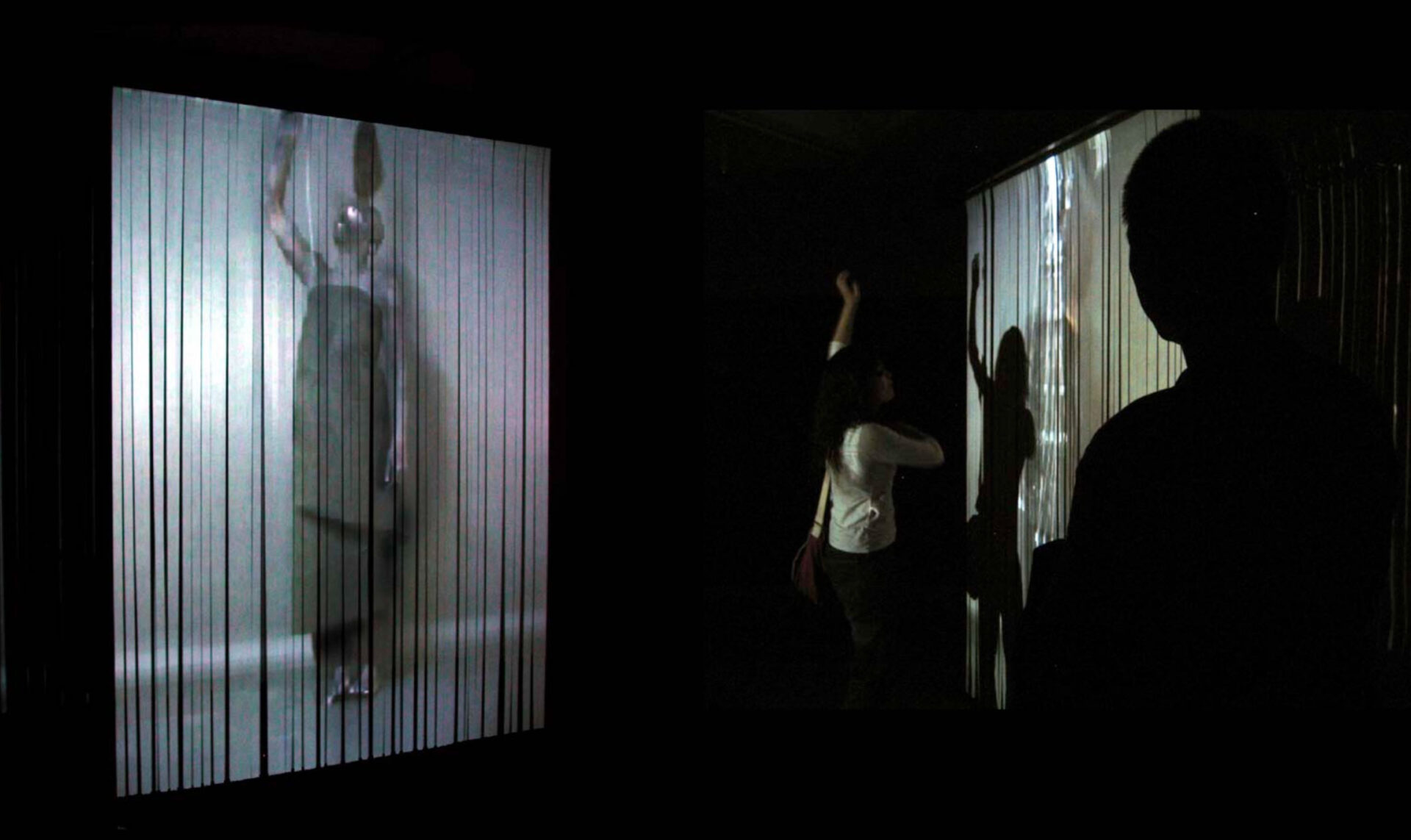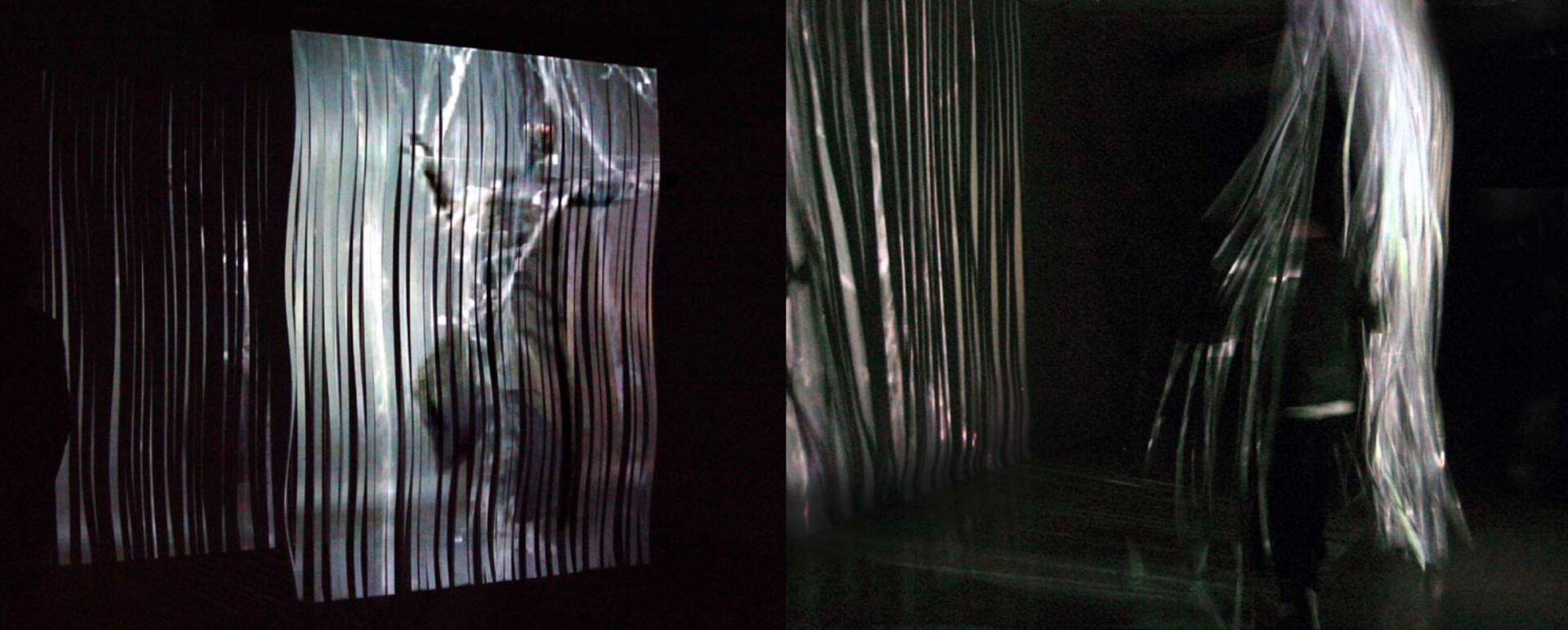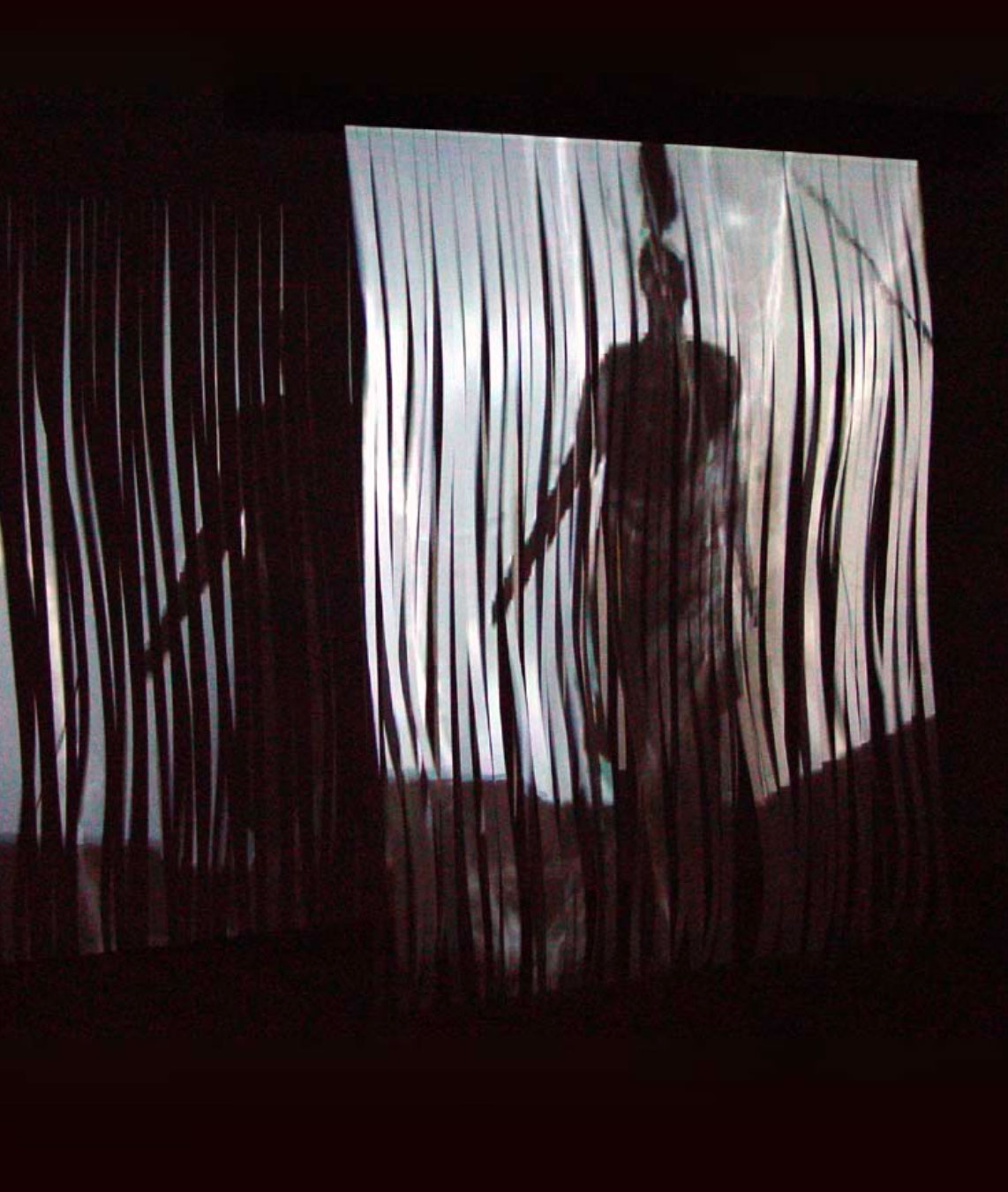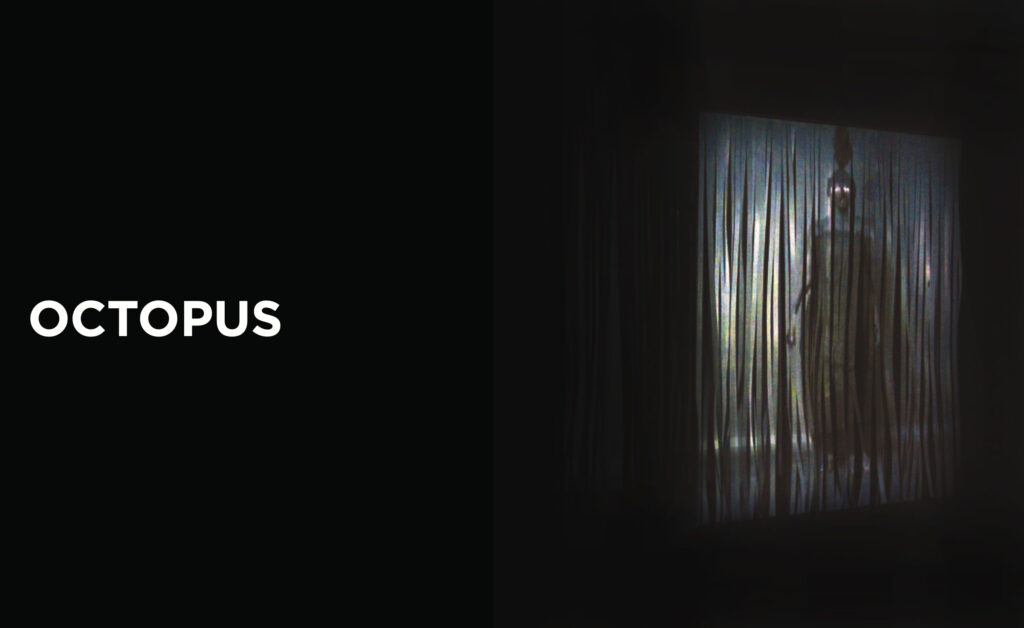
OCTOPUS, Responsive Art System. (Immersive environment; robotics; interactive narrative; sensing and control system; user interface design; large scale projection; tangible interfaces; responsive video membrane; virtual character; recorded performance; and digital sound)
OCTOPUS explores how people relate to space while being constrained by it while having the opportunity to adapt to it. This installation consists of a virtual character projected onto a robotic sculpture that hold a see-through membrane of narrow vertical strips. Visitors can experience up to three modes of communication. First, there is a period of “construction” when the virtual character is completely concentrated to the fabrication of this own environment. During that period, it is impossible to directly interact or communicate with the character. The second mode is the waiting period where the character is aware of what is happening in the gallery’s space. A network of sensors is placed strategically within space and the data is received by the infra-red sensors and is sent to the programming environment, which triggers the third mode: the reaction. Related to the distance from the screen and position of the visitors in the room, the character can reacts in six different ways and the environment (its screen) responds to that sudden change. As the structure and character awaken, moving from a state of calm to agitation, the installation elicits reflections on the interrelationship between body, media, and space. “As its struggle to free itself reaches a climax, the screen starts to move, swaying like seaweed in a strong current; creature and environment dance together as the figure shakes itself free only to become tangled once more,”1 states art historian Alison Syme. Julie Bouchard comments on its interactivity: “In Octopus, the individual only takes shape within space by incorporating the presence of the other in his movements, always remaining an emerging form.”2 This system was recognized for its innovations with the 2005 FICFA Judith Hamel Award in digital art as well as with the 2003 Prize of Excellence in New Media Art by the Hexagram Institute for Research and Creation. Represented by Group Molior, this project was exhibited at the Hong Kong Art Center in Hong Kong (2007), at the 19e Festival International FICFA in Moncton (2005), at the FILE – Electronic Art Festival in Sao Paulo, Brazil (2004), in the Oboro Gallery in Montreal (2004) and at the Society of Art and Technology (SAT, 2003).
1. Alison Syme, “The Various Contrivances of Philomène Longpré,” Isomorphism, Art Interdisciplinary Field, March, 2012, 60-61.
2. Julie Bouchard, “Octopus: Une installation vidéo interactive de Philomène Longpré,”
Archée, revue Cybermensuel Art, section critique, November, 2004.
Octopus- An interactive video system by Philomène Longpré
by Julie Bouchard, Invited curator, Group Molior
It is space that gives us body. It places us upright, stretches us against the horizon, shapes our gestures and even our thoughts and feelings. We picture it as empty, though it is charged and restrictive. We think of it as geographic, social, national, economic, relational, cultural, virtual or spiritual, but it is all these at once. Composite and bound up with time, the space is a dimension that determines our relationship with the world.
Space has, for many years, been the subject of Philomène Longpré’s research into plastics and aesthetics. As a young artist, she focused on her own interior spaces, seeking to make them visible by giving them shape and colour. She quickly realized that this interior space spilled out into the exterior. She followed them, to Asia. There, in the countries where numbers become multitudes, she rediscovered space through its absence, through its invasion. She discovered that, when space is defined in alterity, she was no longer always the subject of her own movements. Surrounded and even defined by the Other, she felt the Other’s movements resonating within. But it was also there, in a constraining space, that she sensed another, incipient space, no longer physical and restricted, but virtual, potentially infinite, one in which she could potentially deploy herself uniquely. Physical space, virtual space, her own space … Philomène Longpré returned from her travels in Asia with a renewed concept of space. It now appears simultaneously composite and relative to the person experiencing it, determinant for the person passing through it, and potentially determined by the person who inhabits it. Once again in Montréal, Philomène Longpré is learning to make this space visible through Concordia University’s electronic arts program.
Video image, digital language and technologies, the body and space of intervention are the raw materials for Philomène Longpré’s work. With the video image, she can unlocate space, reduce it, and give it a grip on time. She begins to create the spatio-temporal objects that digital technologies open up for daily space. Digitized, the image becomes responsive to movement captured in the environment. Philomène Longpré’s space thus becomes heterogeneous, blurring the boundaries between image and reality, virtual and physical space. The human being is both the subject and object of continuous movement. The being must experience the constraints forced on him by space, adapt to them, and find his own space. The being’s entire physicality attests to the integrity of presence; it at once joins the environment in instantiating body, and detaches from it, to incorporate the environment through spirit. In the video installations Plato’s Cavern (2000), Cycle (2001), Passage (2002) and Silence inexistant (2002), Philomène Longpré turns the conquest of space into an aesthetic challenge. Octopus (2003) takes up this challenge once more. Here, space is network, time is cyclical, and the individual is constantly redefined by the Other.
A body / subject
An interactive video installation, Octopus creates an environment that integrates visitors, without their knowledge. Visitors first discover a video image projected onto a structure that hangs in space. Mobile, the structure is made up of narrow vertical slats. It does not touch the ground, simply casting its shadow upon it. It provides a surface for the image, yet also allows light to pass between its slats; in the space behind it, streaks of light form in the space behind it. A source of shadow and light, the structure and the image join the environment as body. The image adds a cyclical temporal dimension; its movement contains three moments, though none are beginning or end. The moments follow one another, without preceding one another.
First moment. An individual being builds his own space. Born from the image, he joins with the structure—which he exceeds by action—to create body. Neither man nor woman, he or it shows no face, has no specific identity, incarnates no particular state. This is a being, the verb to be itself. The matter needed to build a space is not in the immediate environment, but well beyond it. He draws it from that elsewhere that is greater than the structure. Slowly, using a movement that unites heaven and earth, he surrounds himself with a fine, translucent material that will soon form a cloak, to envelop the being and protect him without enclosing. For the moment, the project unfolding absorbs the being, alienates him from what is going on around him. Each of his movements is serene. He is the subject of movement. And, it is as a bodysubject of an action that excludes them that visitors observe him.
To the conquest of space
Second moment. The individual has stopped. His body is surrounded by thin, translucent threads. Still part of the environment, he has constructed his space. Octopus’ environment has become enhanced. The physical space, a space shared by the individual and visitors, now contains a space specific to the individual. It touches both heaven and earth, a small cosmogony. The individual settles in it, expectant, but expecting nothing in particular. It expresses nothing other than a full, entire presence to the world. His gaze turns on the world, toward the visitors.
Though the individual is now simply presence in Octopus, the visitors become interactors in it, but without being aware of it. They may willingly try to create an exchange with the being who now appears to be observing them, expecting something from them. But what? Philomène Longpré gives visitors freedom to answer this question. The Octopus space becomes the space that visitors can experience in their own way. The multiple and relative are invited to deploy themselves. They will be seen as they are. But no matter how they act, if the visitors provoke a change in Octopus’ environment, and the being responds to that change, it will never be willingly, on either side.
Third moment. Packed with sensors, Octopus’ space is enervated. It captures visitors’ movements without their awareness, and relays them toward the structure. The fragile structure reacts and its reactions draw the image into a movement that is both destructive and transitory. The individual’s space trembles and is destroyed. The individual loses his contours, melts into an environment that has become chaos, all reaction. Once subject of his own movements, the individual is now the object of a movement whose source he does not know. He is carried away, like the structure. Then, slowly, calm returns; the structure regains stability, the image takes shape once more, the individual reappears, a single corporal presence. Affirming the necessity of gesture simply by repeating it, he begins once more to build his own space in an environment that remains as sensitive to the Other’s presence.
Boundaries of the subject
Octopus renders visible the connections that, playing with consciousness, unite individuals who share a single space-time. By placing the human being at the heart of a networked space, Philomène Longpré subjects it to constant, omnidirectional flux. By putting him into movement, she gives him body. By making him the subject of a small cosmogony, she has created an individual within the group. And, finally, by making the body/subject sensitive to his environment, she has explored the frontiers of individuality. In Octopus, the individual only takes shape within space by incorporating the presence of the Other in his movements, always remaining an emerging form.
Julie Bouchard | Trained in cognitive computing, Julie Bouchard has been working in dance and media arts since 1999. She has filed many articles with Le Devoir and the journal Liberté as both a journalist and critic. In December, 2000, she also took on the role of managing editor for a special publication on contemporary dance. As a curator, she is interested in the emergence of new languages of the body under the influence of the new technologies, particularly in the growing ties between body languages and digital language.
Awards
- The Judith Hamel Award in digital art. FICFA. Canada. 2005
- Prize of Excellence in New Media Art, HEXAGRAM Institute for Research and Creation. May 2003.
Exhibitions
- AIR Scheme. Hong Kong Arts Center. Curator: Groupe Molior
, Hong Kong, China. April, 2007.
http://www.molior.ca/communiques/comm_PLongpre_hk_060407_eng.pdf - 19e Festival International FICFA- Nouveaux médias. Curator: Angèle Cormier, Group Molior
. Moncton, NB, Canada, September, 2005
http://galeriesansnom.org/node/325
http://www.molior.ca/communiques/comficfa20050912-en.pdf
http://www.ciam-arts.org/archives/archives_autres/2005_09/Molior/
http://www.artic.edu/webspaces/ats_mfa/html/news.html - FILE, Electronic Art Festival. SESI Art Gallery. Le Groupe Molior
(Sao Paulo, Brazil)
March, 2004
http://www.molior.ca/communiques/comm_file_161104.html - Oboro Gallery. Groupe Molior.
(Montreal, Canada)
, February, 2004
http://www.oboro.net/fr/season/saison-2003-2004-fr
http://www.ciam-arts.org/archives/archives_autres/2004_03/Molior/index.htm
http://www.molior.ca/communiques/comm_octo_oboro.html - Promo 4.3, Festival Digital Art. SAT, Société des arts et technologie. (Montreal Canada) . April, 2003 http://www.sat.qc.ca/
Reviews
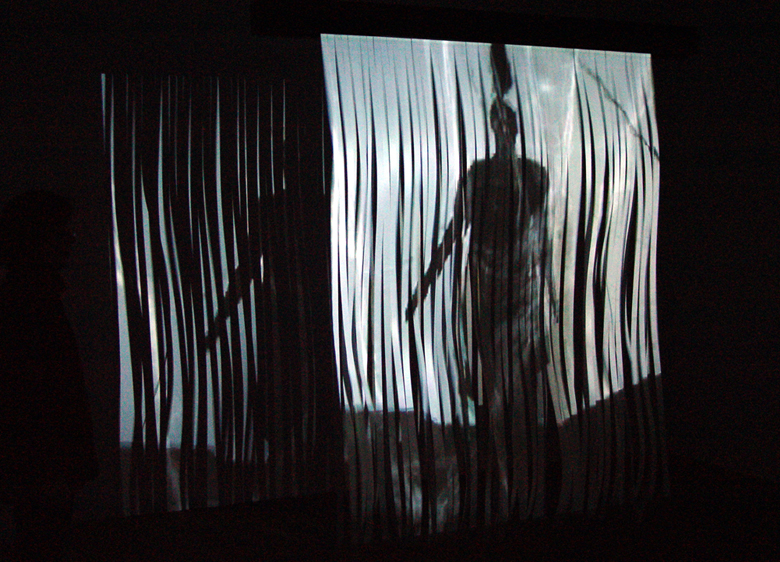
- Bouchard, Julie. “Octopus : Une installation vidéo interactive de Philomène Longpré”, Archée, Cybermensuel Art Magazine, Critique section Quebec, Nov. 2004
http://archee.qc.ca/ar.php?page=article&no=225 http://e-artexte.ca/18731/
https://www.philox.net/julie-bouchard/ - Octopus- Philomène Longpre.
Journal Oriental News, Hong Kong, April 28 2007
https://www.philox.net/wp-content/uploads/Philomene_Longpre_Oriental.jpg - Octopus- CIBERARTE: UMA APROXIMAÇÃO EM 3 DIMENSÕES [SEMIÓTICAS].
VÍVIAN MARA SILVA GARCIA, Brazil, December 20 2006
http://busca.unisul.br/pdf/86458_Vivian.pdf - Octopus : Une installation vidéo interactive de Philomène Longpré
par Julie Bouchard.
Archée, Nov. 2004
http://archee.qc.ca/ar.php?page=article&no=225
http://e-artexte.ca/18731/ - Charting space Philomène Longpré’s electronic octo-art entices by Christine Redfern, Noisemarkers 2004 – Mirror, ARCHIVES: Jan 08-14.04 Vol. 19 No. 29
- Willis, Elena. “In One-hundred Words or Less- Octopus”. This Side. April 09, 2004.
http://www.welovemusique.com/modernart.php - Exhibition Review Philomène Longpré’s Octopus By Crystal Dunham. Moncton, Canada. September, 2005.
https://www.philox.net/wp-content/uploads/Philomene_Longpre_Exhibition_review.pdf
